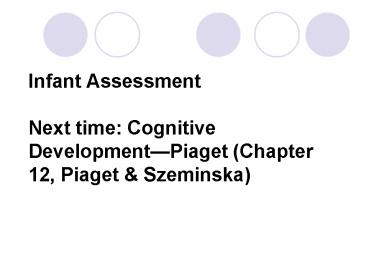Infant Assessment Next time: Cognitive DevelopmentPiaget Chapter 12, Piaget - PowerPoint PPT Presentation
1 / 16
Title:
Infant Assessment Next time: Cognitive DevelopmentPiaget Chapter 12, Piaget
Description:
Infant Assessment. Next time: Cognitive Development Piaget (Chapter 12, ... Response decrement to rattle While infant is asleep, shake rattle near ear and ... – PowerPoint PPT presentation
Number of Views:62
Avg rating:3.0/5.0
Title: Infant Assessment Next time: Cognitive DevelopmentPiaget Chapter 12, Piaget
1
Infant AssessmentNext time Cognitive
DevelopmentPiaget (Chapter 12, Piaget
Szeminska)
2
University of Florida Psychology ClubPsi Chi
Honor Society
Joint Meeting with UF Neuroscience
Club Wednesday, March 18, 2009 _at_ 720 PM in NPB
1001
- The Meetings Agenda
- Guest Speaker Dr. Devine, who will discuss
self-injurious behavior. - Kaplan Course Raffle!
- Scholarship Opportunity!
- T-Shirt Design Contest!
- Psi Chi Applications and Fees Due!
VISIT OUR NEWLY UPDATED WEBSITE
http//www.psych.ufl.edu/psichi/
3
Infant AssessmentNext time Cognitive
DevelopmentPiaget (Chapter 12, Piaget
Szeminska)
4
Apgar TestFagan Test of Infant
IntelligenceBrazelton Neonatal Behavioral
Assessment Scale Bayley Scales of Infant
Development
5
- Table 4.5 The Apgar Test
6
A AppearanceP PulseG GrimaceA ActivityR Respir
ation
7
Apgar TestFagan Test of Infant
IntelligenceBrazelton Neonatal Behavioral
Assessment Scale Bayley Scales of Infant
Development
8
Fagan Test of Infant Intelligence
- Fantz preference method
- 10 trials, each with two photographs of the human
face - Before each trial, 20 seconds of familiarization
to one of the faces - Dependent variable time spent looking at the
novel face
9
Apgar TestFagan Test of Infant
IntelligenceBrazelton Neonatal Behavioral
Assessment Scale Bayley Scales of Infant
Development
10
Brazelton Neonatal Behavioral Assessment Scale
(NBAS)The NBAS is based on several key
assumptions. First, infants, even ones that seem
vulnerable, are highly capable when they are
born. "A newborn already has nine months of
experience when she is born," Dr. Brazelton
notes. "She is capable of controlling her
behavior in order to respond to her new
environment." Second, babies "communicate"
through their behavior, which, although it may
not always seem like it, is a rational language.
Not only do infants respond to cues around them,
like their parents' faces, but they also take
steps to control their environment, such as
crying to get a response from their caregivers.
Third, infants are social organisms, individuals
with their own unique qualities, ready to shape
as well as be shaped by the caregiving
environment.
11
Brazelton Neonatal Behavioral Assessment Scale
(NBAS)
- 0 to 2 months
- 28 behavioral items and 18 reflex items
- Emphases control of state
social interaction optimal performance
12
NBAS Clusters
- Habituation
- Orientation
- Motor
- Range of State
- State Regulation
- Autonomic Stability
- Reflexes
13
Examples of Items from the Neonatal Behavioral
Assessment ScaleItem DescriptionResponse
decrement to light While infant is asleep, shine
light in eyes and observe response after
response disappears, wait 5 seconds and
re-present continue for either 10 trials or
until habituation occurs.Response decrement
to rattle While infant is asleep, shake rattle
near ear and observe response continue
for either 10 trials or until habituation
occurs.Inanimate visual orientation Slowly move
a red ball across the infants field of
vision record ability to track both
horizontally and vertically.Animate visual
orientation Have examiner slowly move his or
her face across the infants field of
vision record ability to track both
horizontally and vertically.Animate auditory
orientation While out of the infants line of
sight, have examiner speak softly into
babys ear record ability to localize on
each side.
14
Apgar TestFagan Test of Infant
IntelligenceBrazelton Neonatal Behavioral
Assessment Scale Bayley Scales of Infant
Development
15
The Mental Scale is designed to assess
sensory-perceptual acuities, discriminations, and
the ability to respond to these the early
acquisition of object constancyand memory,
learning, and problem solving ability
vocalizations and the beginnings of verbal
communication and early evidence of the ability
to form generalizations and classifications,
which is the basis of abstract thinking.
16
The Motor Scale is designed to provide a measure
of the degree of control of the body,
coordination of the large muscles and finer
manipulatory skills of the hands and fingers. As
the Motor Scale is specifically directed towards
behaviors reflecting motor coordination and
skills, it is not concerned with functions that
are commonly thought of as mental or
intelligent in nature.































